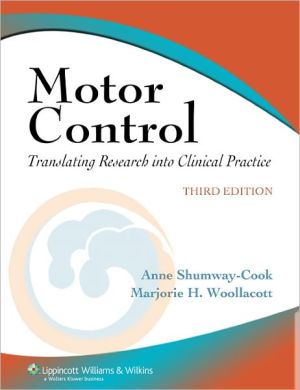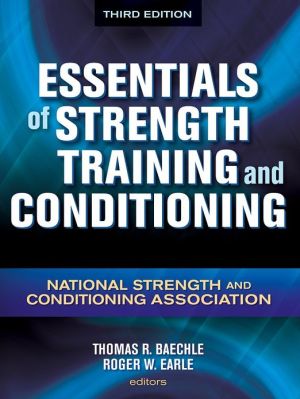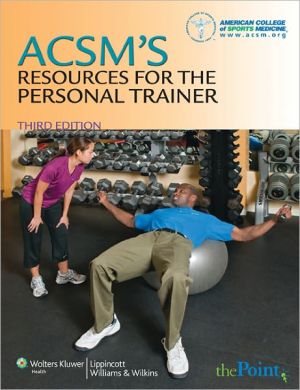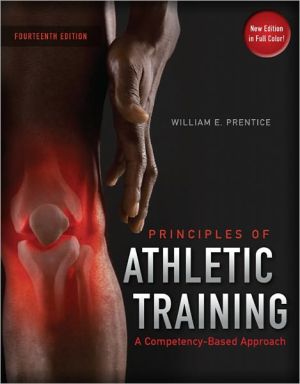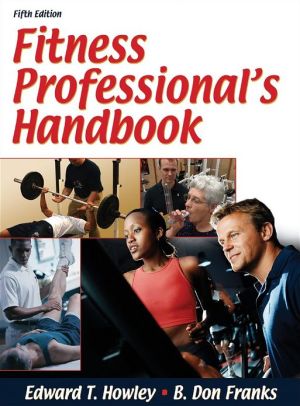Motor Control: Translating Research into Clinical Practice
Motor Control is the only text to bridge the gap between current motor control research and its applications to clinical practice. The text prepares therapists to examine and treat patients with problems related to balance, mobility, and upper extremity function, based on the best available evidence supporting clinical practice. This edition provides the latest research findings and their clinical applications in postural control, mobility, and upper extremity function. Drawings, charts,...
Search in google:
Motor Control is the only text to bridge the gap between current motor control research and its applications to clinical practice. The text prepares therapists to examine and treat patients with problems related to balance, mobility, and upper extremity function, based on the best available evidence supporting clinical practice.The Third Edition features a new two-color design with an updated art program. This edition provides the latest research findings and their clinical applications in postural control, mobility, and upper extremity function. Drawings, charts, tables, and photographs clarify postural control and functional mobility. Laboratory activities and case studies reinforce key concepts. Doody Review Services Reviewer:Christopher James Hughes, PT,PhD,OCS,CSCS(Slippery Rock University)Description:The title of this book accurately reflects authors' intent to bridge the gap between research findings in motor control and clinical practice. Unique to the third edition are teaching materials found at the companion web site. The authors have also included learning objectives and answer keys at the end of each chapter. The second edition was published in 2001.Purpose:The main purpose of this third edition is to provide the most current and emerging research findings for best clinical practice. Providing such an update is crucial. Throughout the book, there is strong evidence that the authors have successfully completed this task.Audience:The format of the book lends itself for use primarily as a classroom text for physical therapy students. The learning objectives, case studies, lab activities, and online materials will assist in teaching this material. In addition, the clinician who needs a quick refresher on the latest research application to clinical practice could also benefit. The authors are well known experts in the field of motor control and rehabilitation.Features:The first of the four major divisions of the book covers the theoretical framework and provides a fundamental understanding of motor learning, motor control, and recovery of function. Part two details normal and abnormal postural control. Part three addresses mobility functions associated with gait, transfers, and stair walking. Part four discusses normal and abnormal reach, grasp, and manipulation. Each of the four sections ends with a case study that highlights the clinical management of problems specific to that section's topic. One impressive feature of the book is the liberal use of sharp and bold figures and tables. The material is organized well and the book is easy to read. Assessment:This is a nice update for those clinicians who have read the second edition. However, it is also for anyone who needs a quick update on the latest research in the field of motor control. Books that do a successful job covering research and clinical correlation of such research are difficult to find. The authors of this book are up to the challenge. Clinicians who need to learn and apply the latest techniques in motor control can easily read this book and understand why it is in its third edition. This is an excellent resource.
1Motor control : issues and theories32Motor learning and recovery of function213Physiology of motor control464Physiological basis of motor learning and recovery of function835Constraints on motor control : an overview of neurologic impairments1006A conceptual framework for clinical practice1367Normal postural control1578Development of postural control1879Aging and postural control21210Abnormal postural control23311Clinical management of the patient with a postural control disorder25712Control of normal mobility29913A life span perspective of mobility33014Abnormal mobility36915Clinical management of the patient with a mobility disorder39016Normal reach, grasp, and manipulation44317Reach, grasp, and manipulation : changes across the life span46818Abnormal reach, grasp, and manipulation49319Clinical management of the patient with reach, grasp, and manipulation disorders518
\ From The CriticsReviewer: Christopher James Hughes, PT,PhD,OCS,CSCS(Slippery Rock University)\ Description: The title of this book accurately reflects authors' intent to bridge the gap between research findings in motor control and clinical practice. Unique to the third edition are teaching materials found at the companion web site. The authors have also included learning objectives and answer keys at the end of each chapter. The second edition was published in 2001.\ Purpose: The main purpose of this third edition is to provide the most current and emerging research findings for best clinical practice. Providing such an update is crucial. Throughout the book, there is strong evidence that the authors have successfully completed this task.\ Audience: The format of the book lends itself for use primarily as a classroom text for physical therapy students. The learning objectives, case studies, lab activities, and online materials will assist in teaching this material. In addition, the clinician who needs a quick refresher on the latest research application to clinical practice could also benefit. The authors are well known experts in the field of motor control and rehabilitation.\ Features: "The first of the four major divisions of the book covers the theoretical framework and provides a fundamental understanding of motor learning, motor control, and recovery of function. Part two details normal and abnormal postural control. Part three addresses mobility functions associated with gait, transfers, and stair walking. Part four discusses normal and abnormal reach, grasp, and manipulation. Each of the four sections ends with a case study that highlights the clinical management of problems specific to that section's topic. One impressive feature of the book is the liberal use of sharp and bold figures and tables. The material is organized well and the book is easy to read. "\ Assessment: This is a nice update for those clinicians who have read the second edition. However, it is also for anyone who needs a quick update on the latest research in the field of motor control. Books that do a successful job covering research and clinical correlation of such research are difficult to find. The authors of this book are up to the challenge. Clinicians who need to learn and apply the latest techniques in motor control can easily read this book and understand why it is in its third edition. This is an excellent resource.\ \ \ \ \ BooknewsFocuses on scientific and experimental principles in neuroscience and motor control, using a functional rather than diagnostic approach. Chapters on theories of motor control, posture, mobility functions, and upper extremity control include case examples of theoretical models, outlines and summaries, and practical experiments and exercises. Contains b&w diagrams and drawings, a glossary, and a postural control assessment form. Annotation c. Book News, Inc., Portland, OR (booknews.com)\ \
